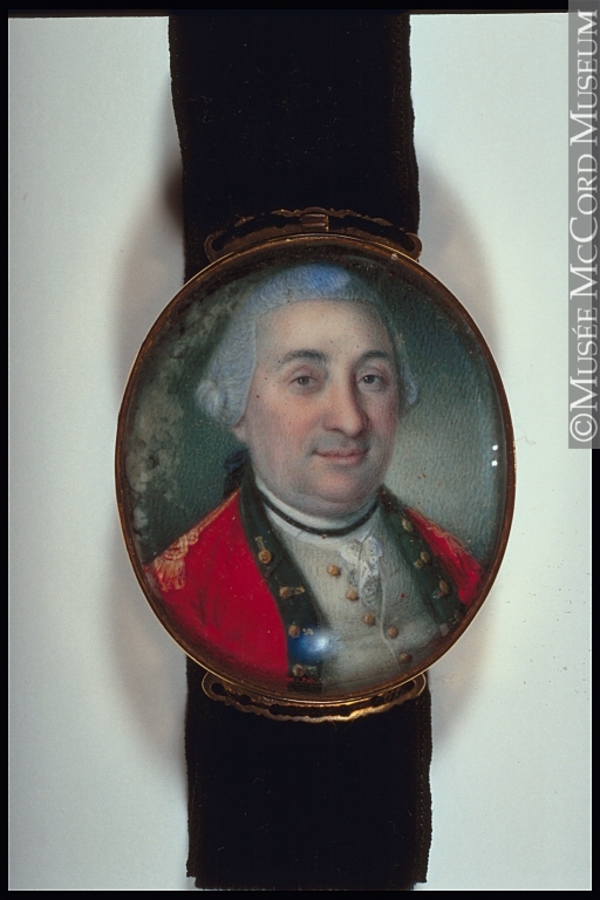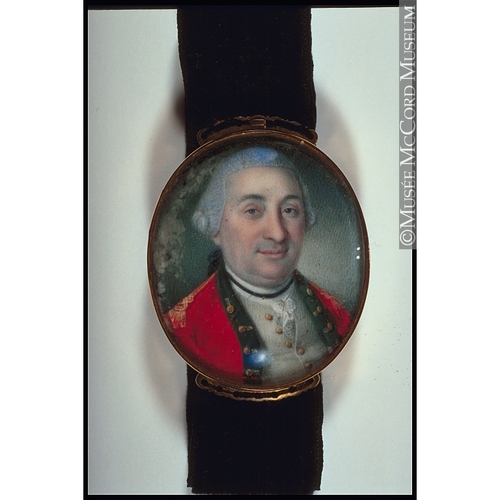
Source: Link
SAINT-OURS, CHARLES DE (baptized Roch-Louis), militia and army officer, seigneur, and politician; b. 24 Aug. 1753 at Quebec, youngest son of Pierre-Roch de Saint-Ours, an officer in the colonial regular troops, and Charlotte Deschamps de Boishébert; d. 11 Nov. 1834 in Saint-Ours, Lower Canada.
Charles de Saint-Ours, a distinguished representative of the old aristocracy that stayed on in the colony after the conquest, had a brilliant military career that has sometimes, however, been attributed to his ready cooperation with the British authorities. He was only 22 when the American War of Independence broke out in 1775. The previous year he had been made a major in the militia, and he soon took part in his first military exploit, joining a volunteer corps raised to defend Fort St John’s (Saint-Jean-sur-Richelieu). After its surrender he was taken as a prisoner to the American colonies.
On 26 June 1777, having returned to the province of Quebec, Saint-Ours was commissioned a lieutenant in one of three companies of Canadian volunteers which were raised to accompany British armies on an offensive into New York State that year. On 11 December he became aide-de-camp to Governor Sir Guy Carleton*, an office he also held under Frederick Haldimand* and again under Carleton (by then Lord Dorchester). He was promoted captain-lieutenant in the 84th Foot in 1783 and was placed on half pay later in the year. Saint-Ours was one of four aides-de-camp to Prince William Henry, later William IV, during his stay in the province in 1787. He was appointed lieutenant-colonel of the Chambly battalion of militia in 1790, promoted brevet major in the regular army four years later, and then made captain in the 60th Foot on 2 Dec. 1795. He was placed on the half pay of the 132nd Foot in 1796. At the outbreak of the War of 1812 he was colonel of the Saint-Ours battalion of militia. He was profoundly shocked at the attitude taken by some of the local residents at the time of the Lachine riot against conscription and he strongly condemned it. Garrisoned with his battalion at William Henry (Sorel) until it was demobilized on 26 Nov. 1812, he was recalled in October 1813. He was then stationed at Chambly, where he remained until the end of the war.
Saint-Ours had travelled in Europe in 1785. He had gone with his cousin, Charles-Louis Tarieu* de Lanaudière, and was received first at the British court, where George III showed the highest regard for him. In France he was admitted into the presence of Louis XVI and the royal family, a visit he fondly remembered, particularly after the revolution. Moving on to Prussia, he learned that Frederick II was to review the army. He requested permission to attend and was sent a signed note from the king, giving his assent. He kept the note all his life and enjoyed showing it to his acquaintances as a memento of one of his happiest experiences.
In 1782 Saint-Ours had inherited part of the seigneuries of Saint-Ours, L’Assomption, and Deschaillons. From then on he had two concerns: to reconstitute Saint-Ours, and to build on it a manor-house that he would make the centre of his endeavours as a seigneur. He took more than 30 years to achieve his first goal, obtaining his brother Charles-Quinson’s right on 2 July 1790, his sister Jeanne-Geneviève’s on 4 March 1806, and his brother Paul-Roch’s on 18 March 1812. But it was actually not until 12 Oct. 1827 that he brought the project to completion, by using his status as attorney for the heirs of his uncle Jacques-Philippe de Saint-Ours to sell their share to his son François-Roch. Some 12 years later François-Roch would reunite with the main fief the part owned by the heirs to the seigneury of Contrecœur. In an area between the St Lawrence and the king’s highway, about two arpents north of the parish church, Charles had constituted a domain of about 20 arpents by exchanging and buying pieces of land already granted to censitaires, and on it the construction of a manor-house was begun in 1792. Graceful avenues, lawns, and flower-beds were laid out, and the whole estate was planted with trees and flowers of various sorts, so that it was known locally as a “little paradise on earth.” The attraction of the estate for Montreal and Quebec society became legendary, as did the glittering parties held there. Saint-Ours actively concerned himself with the development of his seigneury. In the period 1781–1827 he made more than 400 land grants, and while engaged in opening roads and building bridges to promote trade in grain, he also took part in establishing Saint-Jude parish in 1822, where his flourishing lumbering enterprises were located.
Like his brother Paul-Roch, Saint-Ours was appointed to the Legislative Council, on which he sat from 2 Dec. 1808 until his death. He spent the final years of his life promoting education. In 1821 he had supported Antoine Girouard, the founder of the Collège de Saint-Hyacinthe, by putting his library at the service of the teachers, and by founding an association for improving educational opportunities in the Rivière Chambly area. This organization sought to recruit gifted children and assure them board and tuition for an eight-year period. It lasted until 1829 and paid out some $4,500 to the pupils, a number of whom came from Saint-Ours where the seigneur encouraged the building of schools.
Charles de Saint-Ours was blessed with good health and remained active until his death on 11 Nov. 1834. He was buried three days later in the parish church. He and Josette Murray probably were married in 1792, and they had three children: Josette, who married Pierre-Dominique Debartzch*, Charles-Pierre, and François-Roch. The Patriotes, in particular Jean-Joseph Girouard*, have represented François-Roch as “the bête noire of the prisoners,” “the old bear of a sheriff” who was detested by those held captive. As for Mme de Saint-Ours, she died in 1840 and was buried beside her husband in the parish church.
ANQ-Q, CE1-1, 24 août 1753; CE3-6, 14 nov. 1834. PAC, MG 23, GII, 6; RG 31, C1, 1825, 1831, Richelieu. La Minerve, 13 août 1832. Quebec Gazette, 16 Aug. 1787; 5 May 1791; 17 July 1794; 15 Aug. 1811; 21 Nov. 1816; 6 Jan. 1820; 5 April, 7 June 1821. F.-J. Audet, “Les législateurs du Bas-Canada.” Bouchette, Topographical description of L.C. Le Jeune, Dictionnaire, 2: 600. Officers of British forces in Canada (Irving). Tanguay, Dictionnaire, 3: 402. Turcotte, Le Conseil législatif. F.-J. Audet, Contrecœur; famille, seigneurie, paroisse, village (Montréal, 1940). Béatrice Chassé, “Le notaire Girouard, patriote et rebelle” (thèse de d. ès
Cite This Article
Serge Courville, “SAINT-OURS, CHARLES DE (baptized Roch-Louis),” in Dictionary of Canadian Biography, vol. 6, University of Toronto/Université Laval, 2003–, accessed January 19, 2026, https://www.biographi.ca/en/bio/saint_ours_charles_de_6E.html.
The citation above shows the format for footnotes and endnotes according to the Chicago manual of style (16th edition). Information to be used in other citation formats:
| Permalink: | https://www.biographi.ca/en/bio/saint_ours_charles_de_6E.html |
| Author of Article: | Serge Courville |
| Title of Article: | SAINT-OURS, CHARLES DE (baptized Roch-Louis) |
| Publication Name: | Dictionary of Canadian Biography, vol. 6 |
| Publisher: | University of Toronto/Université Laval |
| Year of publication: | 1987 |
| Year of revision: | 1987 |
| Access Date: | January 19, 2026 |



